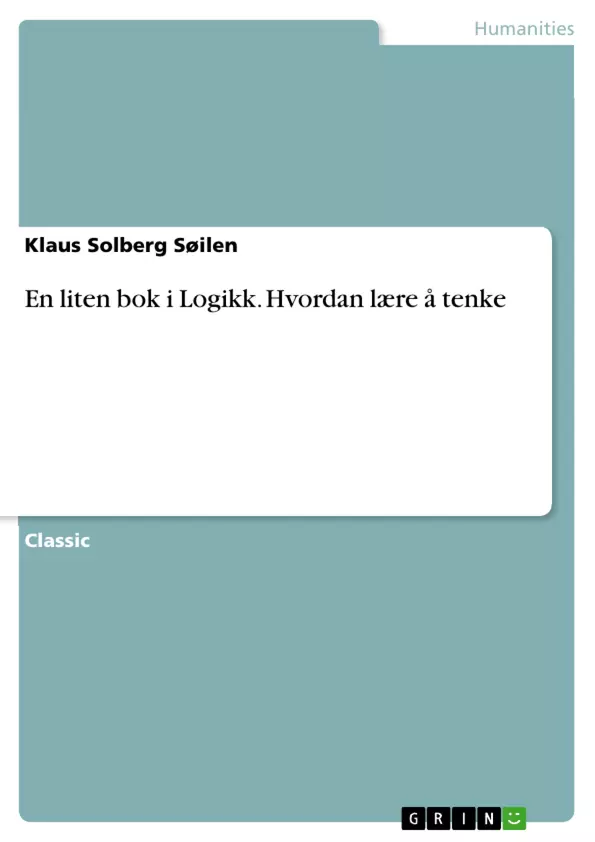Hver eneste dag blir vi bedt om å redegjøre for våre konklusjoner, skriftlig eller muntlig. Vi snakker om analyse og syntese, som betyr ”plukke fra hverandre” og ”sette sammen igjen”. Dette er prosesser vi gjør ikke bare på skolen og på universitetet, men når og hvor som helst i hverdagen. All utdanning bygger på forutsetningen om kjennskap til tankenes prosess.
Inhaltsverzeichnis
- OVERSETTERENS FORORD
- INNLEDNING
- DEL I
- KAPITTEL 1. DEFINISJON AV LOGIKK: FAGETS OMRÅDE OG INNDELINGER
- KAPITTEL II. DE TRE DELENE AV LOGISK DOKTRINE
- KAPITTEL IV. DENNOTASJONEN OG KONOTASJONEN AV EN TERM
- KAPITTEL V. INNDELING
- KAPITTEL VI. DEFINISJON
- DEL II
- KAPITTEL VII. PROPOSISJONEN: DENS KLASSIFISERING
- KAPITTEL VIII. ØYEBLIKKELIGE SLUTNINGER
- KAPITTEL IX. SYLLOGISMEN
- KAPITTEL X. REDUKSJON
- KAPITTEL XI. KOMPLEKSE SYLLOGISMER
- KAPITTEL XII. DILEMMAET
- KAPITTEL XIV. SORITETER
- KAPITTEL XV. ENTYMEMER
- KAPITTEL XVI. FEILAKTIGE ANTAKELSER
- DEL IV
- INDUKSJON. INNLEDNING
- KAPITTEL XVI. VITENSKAPELIG OG UVITENSKAPELIG INDUKSJON
- KAPITTEL XVII. DE INDUKTIVE METODENE
- KAPITTEL XVIII. HYPOTESER
- KAPITTEL XIX. ANALOGI
- KAPITTEL XX. VANLIGE MISLEDENDE ARGUMENT
- KONKLUSJON
- APPENDIX A
Zielsetzung und Themenschwerpunkte
Dieses Buch zielt darauf ab, die Grundlagen der Logik zu vermitteln und den Leser in die Lage zu versetzen, klar und präzise zu denken. Es behandelt verschiedene Aspekte der Logik, von Definitionen und Klassifikationen bis hin zu Schlussfolgerungen und induktiven Argumenten.
- Definition und Bereiche der Logik
- Die drei Teile der logischen Doktrin
- Arten von Schlussfolgerungen und ihre Anwendung
- Induktive Argumentation und wissenschaftliche Methoden
- Fehlerhafte Annahmen und logische Irrtümer
Zusammenfassung der Kapitel
Die ersten Kapitel befassen sich mit der Definition und den Bereichen der Logik, einschließlich der drei Hauptteile der logischen Doktrin. Es werden verschiedene Arten von Begriffen und deren Bedeutungen erläutert, sowie die Prinzipien der Definition und Klassifizierung.
Die folgenden Kapitel behandeln die Theorie der Schlussfolgerungen, einschließlich unmittelbarer Schlussfolgerungen, Syllogismen, komplexer Syllogismen, Dilemmata, Soriter, Entymemen und fehlerhaften Annahmen.
Die letzten Kapitel befassen sich mit Induktion, wissenschaftlicher und unscientifiche Induktion, induktiven Methoden, Hypothesen, Analogie und logischen Irrtümern. Diese Kapitel zeigen die Anwendung logischer Prinzipien auf wissenschaftliche Untersuchungen und Argumentation.
Schlüsselwörter
Die wichtigsten Schlüsselwörter des Buches umfassen Logik, Argumentation, Schlussfolgerung, Syllogismus, Induktion, Deduktion, Definition, Klassifizierung, wissenschaftliche Methode, logische Irrtümer, Begriff, Proposition, und Denkweise.
- Quote paper
- Klaus Solberg Søilen (Author), 2005, En liten bok i Logikk. Hvordan lære å tenke, Munich, GRIN Verlag, https://www.grin.com/document/345680



